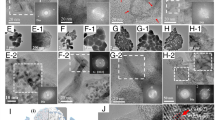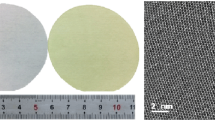Abstract
Removed from the deposition region, an upstream hydrogen microwave plasma generates arsenic hydrides by etching the surface of solid arsenic. The hydrides are transported to the deposition region and mixed with trimethylgallium to achieve low temperature (350°-400°C) and low pressure (750 mtorr) homoepitaxial GaAs films. Low precursor V:III ratios are used to achieve homoepitaxial films with high levels of carbon dopants (l019 to mid 1020 cm−3). No active or afterglow plasma exists in the growth region. The observed homo epitaxial growth activation energies of 54 kcal/mole and 66 kcal/mole for films deposited with V:III ratios of 1:1 and 1:4, respectively, are in the range of those reported for the heterogeneous decomposition of trimethylgallium in the absence of arsine. The films are found to be of good crystalline quality via double crystal x-ray rocking curves. The majority carriers are holes and have hole concentrations that correlate to the carbon doping, as determined by room temperature Hall effect measurements and secondary ion mass spectroscopy. Carrier mobility versus carbon concentration is also presented.
Similar content being viewed by others
References
T.R. Omstead, A.V. Annapragada and K.F. Jensen,Appl. Phys. Lett. 57, 2543 (1990).
N.M. Johnson, R.A. Street, J. Walker and K. Winer,J. Noncryst. Solid 114, 169 (1989).
J. Marinace, IBM Research Report No. 11705. Also G.J. Collins, J.R. McNeil and Z. Yu, U. S. Patent No. 4,952,294 (28 August 1990).
M. Naitoh, T. Soga, T. Jimbo and M. Umeno,J. Cryst. Growth 93, 52 (1988).
D.H. Reep and S.K. Ghandi,J. Electrochem. Soc. 130, 675 (1983).
M. Uneta, Y. Watanabe and Y. Ohmachi,J. Cryst. Growth 110, 576 (1990).
M.G. Jacko and S.J.W. Price,Can. J. Chem. 41, 1560 (1963).
K. Evenson,Rev. Sci. Instr. 36, 294 (1965).
F.W. McLafferty and D.B. Stauffer,The Wiley / NBS Registry of Mass Spectral Data, vol. 1 (New York: John Wiley and Sons, 1988).
W.L. Jolly, L.B. Anderson and R.T. Beltrami,J. Am. Chem. Soc. 79, 2443 (1957).
T.J. Mountziaris and K.F. Jensen,J. Electrochem. Soc. 138, 2426 (1991).
S.T. Picraux, B.L. Doyle and J.Y. Tsau,Mater. Sci. Techn. 33, 139 (1991).
T. Sanada and O. Wada,Jpn. J. Appl. Phys. 19, L491 (1980).
M.C. Hanna, Z.H. Lu, and A. Majerfeld,Appl. Phys. Lett. 58, 164 (1991).
K. Saito, M. Konagi and K. Takahashi,Jpn. J. Appl. Phys. 29, 1900 (1990).
Author information
Authors and Affiliations
Rights and permissions
About this article
Cite this article
Pihlstrom, B.G., Thompson, L.R., Shaw, D.M. et al. In-Situ generated arsine radicals for gallium arsenide homoepitaxy. J. Electron. Mater. 22, 81–86 (1993). https://doi.org/10.1007/BF02665727
Received:
Revised:
Issue Date:
DOI: https://doi.org/10.1007/BF02665727




